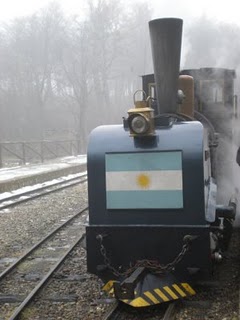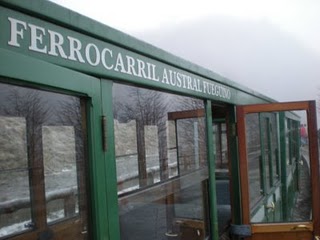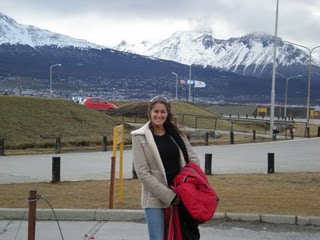Ushuaia, Argentina – Part II
I jumped on the End of the World Train (or in Spanish, El Tren del Fin del Mundo) this morning.
 The three-seat-wide train was equipped with a voice recording that provided us with details on all the locations we passed through in Spanish, English and Portuguese; it was a sight-seeing tour, history lesson and language class, all wrapped into a one hour, 4.3 mile ride.
The three-seat-wide train was equipped with a voice recording that provided us with details on all the locations we passed through in Spanish, English and Portuguese; it was a sight-seeing tour, history lesson and language class, all wrapped into a one hour, 4.3 mile ride.
 The sun didn’t rise until 10 a.m. and the day started off with heavy fog; heavy fog that never lifted. It created a certain, sort of Transylvanian, effect for the train ride as we passed through areas where prisoners once worked.
The sun didn’t rise until 10 a.m. and the day started off with heavy fog; heavy fog that never lifted. It created a certain, sort of Transylvanian, effect for the train ride as we passed through areas where prisoners once worked.
Argentina was very close to losing Tierra del Fuego to Chile due to its lack of population during the early 20th century. In order to keep the island, the Argentine government decided to populate it, but because of its isolation and cold temperatures, convincing people to move, would be difficult. The solution, build a maximum security prison and populate it with hard criminals. Its distance from any city and its surrounding waters never rising above 40-degrees Fahrenheit, made the island an ideal prison location.
The End of the World Train was originally built to transport the prisoners from the prison through the forest where they worked and as far as the most south-western tip of Tierra del Fuego, which is where the Pan American Highway begins, or ends, depending on which way you’d like to look at it (the Pan American Highway connects Tierra del Fuego to Alaska). The prisoners’ job was to cut down trees; the timber was used as fire wood, to extend the rail road and build more buildings.
During our ride, we passed through what is known as the “Tree Cemetary,” an area where the prisoners cut down almost all the trees and most never grew back.
 Ushuaia’s beaver population out-numbers the amount of people and their damn-building habits is another cause for the decline in tree regrowth.
Ushuaia’s beaver population out-numbers the amount of people and their damn-building habits is another cause for the decline in tree regrowth.
The trains’ first stop was at Pipo River. Pipo was a prisoner who tried to escape and couldn’t survive the islands’ weather conditions. He was found dead along a river that is now named after him.
Our second stop was at Roca Lake. It’s named after Julio Argentino Roca, a politician, a General and two-time President.
 There was absolutely no wind, fog covering the snow-capped mountains and the lake was transparent and mirror-like. It was eerie and at the same time, tranquil.
There was absolutely no wind, fog covering the snow-capped mountains and the lake was transparent and mirror-like. It was eerie and at the same time, tranquil.
The trains’ final stop was literally, at the end of the world. It was as far as the rail road stretched and a mere 11,000 miles from Antarctica. Beyond this point, the Atlantic and Pacific Oceans converge.
After the train ride, we visited the prison.
Its five wings are connected by a cafeteria/”playground.” The wings have been converted into different museums. Some relate to the prison and have mannequins within the cells, sitting on cots, standing at the door or sitting at a desk, resembling the prisoners.
Another wing was turned into a museum where art work displayed people’s frustration with the beaver over-population and painted the beavers taking over the world. The paintings were morbidly funny.
Two other wings were closed off and the final wing was the highlight of the museum. It was left completely untouched since the prisons’ closing in 1946. All the lights were removed from within the wing to preserve the paint; I visited at night, so it was hard to see inside the dark corridor. The floor tiles had cracks and a few holes from the prisoner’s shackles and iron ball wrapped around their ankles.
My last day in Ushuaia was very productive and educational.
Headed to El Calafate tomorrow.
For more from Agustina Prigoshin, read her blog at www.agustinaprigoshin.com
FOR ADVENTURES IN CHILE, CLICK HERE




I love it. Is this your forst time taking this trip to Ushuaia? Where are you staying while you are there?
Hi Gabriel! Yes, this is my first time visiting. It’s one of three stops along my south of Argentina trip. I’m staying in Hotel Lennox. I recommend it; very nice, clean and great service.